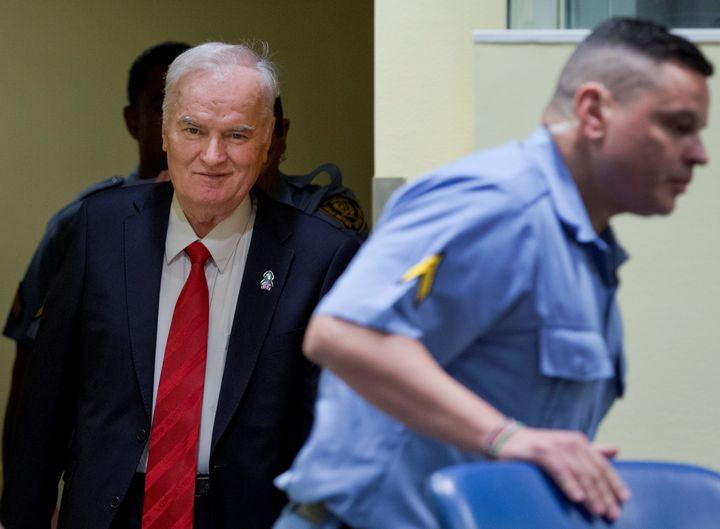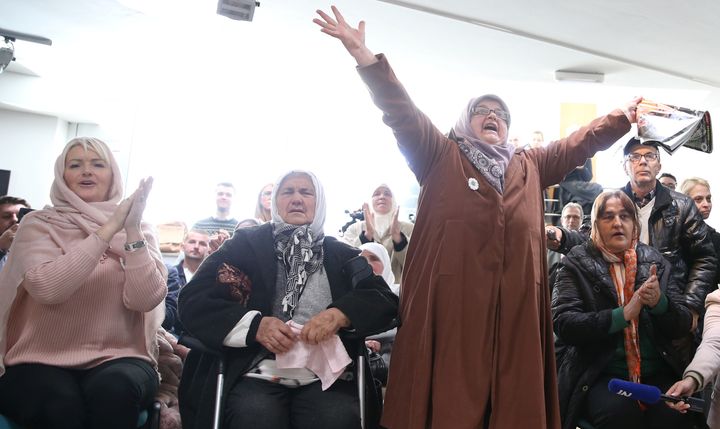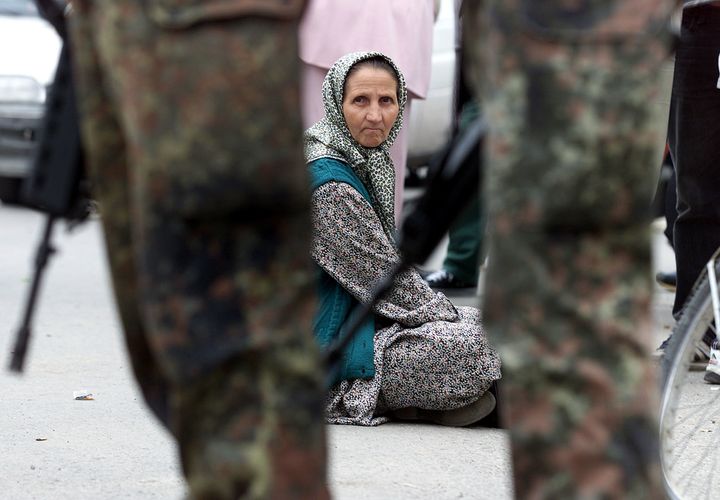
A UN war crimes tribunal has convicted Bosnian Serb military chief Ratko Mladic of genocide and sentenced him to life imprisonment.
Mladic, who became known as the “butcher of Bosnia”, was found guilty after a dramatic courtroom climax in which he was ejected over an angry outburst.
He screamed “this is all lies, you are all liars” after returning from what his son described as a blood pressure test which delayed the reading-out of the judgment.
The 74-year-old was convicted of 10 out of 11 charges. Mladic is to appeal against the convictions, his defence lawyer said later.
He was found guilty of the massacre of more than 7,000 Bosnian Muslim men and boys at Srebrenica in 1995 and the siege of Sarajevo, in which more than 10,000 people died.
“The crimes committed rank among the most heinous known to humankind, and include genocide and extermination as a crime against humanity,” Presiding Judge Alphons Orie said in reading out a summary of the judgment.
“Mladic is the epitome of evil, and the prosecution of Mladic is the epitome of what international justice is all about,” UN human rights chief Zeid Ra’ad al-Hussein said.
“Today’s verdict is a warning to the perpetrators of such crimes that they will not escape justice, no matter how powerful they may be nor how long it may take.”
Who is Ratko Mladic?
“I am General Ratko Mladic. The whole world knows who I am,” he told a pre-trial hearing in 2011. “I am here defending my country and people, not Ratko Mladic.”
Mladic was charged with genocide for the slaughter of 8,000 unarmed Bosnian Muslim men and boys rounded up in the town of Srebrenica, and his forces’ 43-month-long siege of Sarajevo in which thousands of civilians were killed by artillery, mortar, tank and sniper fire from the rugged hills ringing the capital.

From the time of his ICTY indictment in mid-1995, before the war ended, it took 17 years to bring him to trial in The Hague - a testament to the loyalty he inspired among Serbs who helped conceal him and to the resilience of their nationalist cause.
But as Serbia evolved after Bosnia’s war from authoritarian rule to democracy seeking integration with the European Union, Mladic lost his sanctuary.
When Serbian police acting on an ICTY arrest warrant finally traced Mladic to a cousin’s farmhouse in May 2011, they found a penniless, shambling and ill old man.
The son of a World War Two Yugoslav partisan killed in 1945, Mladic was a general in the old communist Yugoslav People’s Army (JNA) when the multinational Balkan republic began to disintegrate in 1991 with the secession of Slovenia and Croatia.
When Bosnia’s Serbs rose up in response to a referendum for independence by Muslims and Croats, Mladic took over Belgrade’s forces in Bosnia which swiftly overran 70 percent of the country with a combination of daring, ruthlessness and brutality.
Serb paramilitaries entered the conflict with a campaign of murder, rape, mutilation and expulsion mainly against Bosnian Muslims. Dozens of towns were besieged with heavy weapons and villages were burned down as 22,000 UN peacekeeping troops stood by more or less helplessly, with orders not to take sides.
Mladic had a cameraman film the blitz of the Muslim enclave of Srebrenica, showing him bronzed and fit at 53, extolling his “lads” and haranguing hapless Dutch UN peacekeepers who took his soldier’s word that the inhabitants would be safe.
Instead, 8,000 of them were systematically executed in a massacre that took several days in July 1995.
TV footage showed Mladic asserting that he had “liberated” Srebrenica and gifted it to Serbs as revenge against “Turks” who ruled the region when it was part of the Ottoman Empire.
What happened at Srebrenica?
Muslim men and boys were separated from women, stripped of identification then shot. The dead were bulldozed into mass graves. The remains were later dug up and hauled away in trucks to be better hidden from the world in more remote mass graves.
Over 6,900 victims have since been identified by DNA tests.

The massacre was the grim culmination of a 3-1/2-year conflict in which the beefy general had pounded Sarajevo daily with the entire Bosnian Serb arsenal, killing over 11,000 people, until local sports fields were overflowing with graves.
His goal, ICTY prosecutors said, was ethnic cleansing - the forcible extermination or expulsion of Muslims, Croats and other non-Serbs to clear Bosnian lands for a “Greater Serbia”.
Prosecutors said it was a conspiracy in which Mladic and Karadzic were aided, armed and abetted by Milosevic.
Only a combination of Western pressure and covert American arms and training for Croats and Muslims turned the tide in 1995 against Mladic’s army, ultimately depriving it of equipment and fuel supplies from Serbia. NATO air strikes did the rest.

He spent only half his time at large as a hunted fugitive. Even after Milosevic fell to a pro-democracy uprising in 2000, Mladic remained well protected in various Belgrade apartments until 2005.
He received treatment at a top military hospital. Sporadic sightings put him at a Belgrade horse race or soccer match.
When finally arrested in the shabby rural farmhouse, he put up no resistance. His right arm was lame, the apparent result of an untreated stroke.
His trial had to be delayed over and over because of his shaky health. Yet in court, Mladic grinned as a judge read out the charges of genocide, war crimes and crimes against humanity.
Srebrenica massacre survivors attending one hearing were shocked when he made a throat-slitting gesture towards a Muslim woman who had lost her husband, son and several brothers.
In 2014, he refused to give evidence in support of old ally Karadzic, calling the tribunal a “satanic court”.
Whatever the verdict on Wednesday, Mladic’s trial is unlikely to further post-war reconciliation in Bosnia.
The US-brokered Dayton Accords of 1995 halted the bloodshed by dividing Bosnia into a semi-autonomous Serb Republic entity and a Bosniak-Croat Federation. This did not heal ethnic splits or prevent a resurgence of Serb separatism.
Most Bosnian Serbs remain convinced that Mladic is innocent. If he is found guilty, it will only prove their conviction that the Hague tribunal is utterly biased against Serbs.
“I am a very old man ... and I am not important,” Mladic told the tribunal. “It matters what kind of legacy I will leave behind, among my people.”